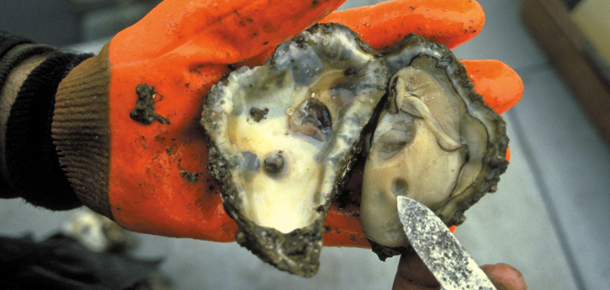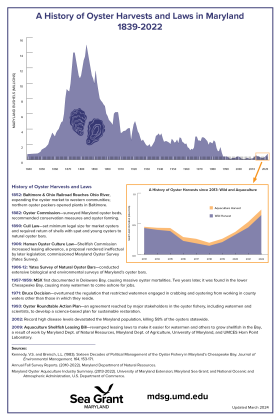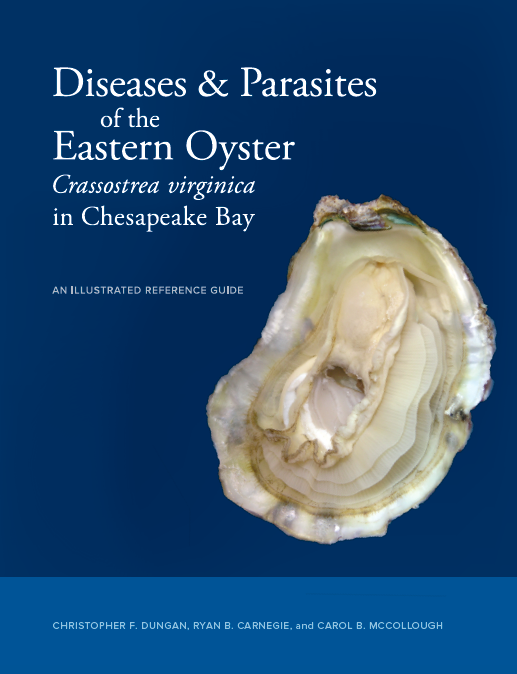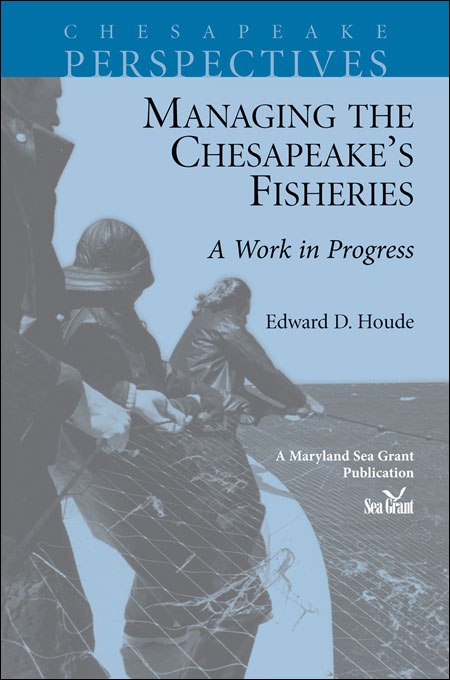Knauss legislative fellowships in Congress help build careers — and they're fun and educational. See our video and fact sheet for details.
Oysters

The Chesapeake Bay was once home to vast numbers of oysters — oyster reefs rose so high that they grazed the bottoms of boats sailing the Bay. A nationwide trade in oysters grew up with the Bay at its heart.
These native oysters — the Eastern oyster (or Crassostrea virginica) — also played a key ecological role in the Chesapeake. They filtered algae and provided habitat and shelter for other animals and underwater plants.
Today, the Bay’s oyster population stands at a difficult crossroads. Decades of overharvesting and diseases such as Dermo and MSX have left the Chesapeake’s iconic oysters in a precarious state, at only about one percent of the numbers present in the nineteen century.
Scientists and policy makers are exploring ways to restore oysters to the Bay. Reef building, establishing protected sanctuaries, and breeding disease-resistant oysters may all be key to fostering a comeback of Crassostrea virginica. The oyster will need all the help it can get.
Maryland Sea Grant has supported a variety of research, education, and public-outreach projects related to this famous shellfish of the Chesapeake Bay.
Learn about the work of Maryland Sea Grant Extension: Our agents and specialists work to support oyster aquaculture and restoration. We grow oyster seed for oyster farming and for projects to restore reefs of wild oysters in the Bay. We also provide technical advice about aquaculture methods, business financing, and public policy.
Check out this sampling of our diverse information resources about oysters, including publications, articles, and videos.
Scholarly Publications
- The Eastern Oyster: Crassostrea virginica, hardcover textbook, 772 pages, for sale through our Bookstore: A comprehensive synthesis about the species’ biology with sections on population genetics, reproduction and larval biology, pollution and environmental effects, and diseases and mechanisms of defense.
- Maryland's Oysters: Research and Management, an earlier critical review and synthesis.
- Native Oyster Restoration in Maryland and Virginia — An Evaluation of Lessons Learned 1990-2007, A Preliminary Report: Insufficient data exists to show whether oyster restoration efforts in the Bay have resulted in increasing numbers of oysters, according to a review by a scientific panel convened by Sea Grant. This publication is the panel’s report, which recommends improvements in data collection and the coordination of restoration efforts.
- “Sixteen Decades of Political Management of the Oyster Fishery in Maryland’s Chesapeake Bay”: An analysis by scholars at the University of Maryland Center for Environmental Science
- Oyster Research and Restoration in U.S. Coastal Waters: Developing Strategies for the Future, a 2003 workshop that critically assessed the effectiveness of the Oyster Disease Research Program and Gulf Oyster Industry Program and to clearly define research needs to meet the goals of restoration and fisheries enhancement. Download the workshop summary pdf and processings pdf.
Browse and search Maryland Sea Grant’s Bookstore for additional reprints and other materials.
Articles in Chesapeake Quarterly magazine
- “The Oyster Dreams of W.K. Brooks” (article): At the turn of the 20th century, Brooks became the first great oyster scientist in America and an early (and unsuccessful) advocate for oyster farming in Maryland waters. His ideas outlived his enemies, especially his belief that science should be applied to managing the oyster fishery.
- A Future for Oyster Farming (issue): Entrepreneurs are working to build a new industry of oyster aquaculture in Maryland. And Virginia scientist Stan Allen pioneered the development of sterile (triploid) oysters that are resistant to oyster diseases — oysters that may help revive the Bay’s oyster fishery.
- The MSX Files: Unmasking an Oyster Killer (issue): Two scientists at the Virginia Institute of Marine Science used new genetic techniques to solve a decades-old mystery: where did MSX, a disease that devastated the Bay’s oysters, come from?
- Skipjacks for the 21st Century (issue): As scientists work to restore the Bay's oyster reefs, maritime heritage programs have worked to repair and keep afloat the nation's last commercial sailing fleet — the skipjacks used to harvest oysters in the Chesapeake.
Many additional articles about the science and history of oysters in the Chesapeake Bay have appeared in Maryland Marine Notes and Maryland Aquafarmer, both formerly published by Maryland Sea Grant. Browse these publications’ archives or search our site to find these articles.
K-12 Lessons
- Interactive lessons about oysters, "Oysters in the Classroom."
- School teachers have written lesson plans, including on oysters, during workshops led by Maryland Sea Grant. See more on our lesson-plans page.
Maryland Sea Grant Documentaries and Short Videos
- Who Killed Crassostrea virginica? The Fall & Rise of Chesapeake Bay Oysters, documentary film: The Chesapeake was once home to the richest oyster grounds in the world. Who killed the Bay's native oysters? This award-winning, hour-long documentary sets out to answer that question. The film details both the poignant destruction of a fabled fishery and the prolonged scientific inquiry into the origins of a killer parasite. Watch trailer, below.
- Rebuilding the Bay’s Reefs, a short video: At the University of Maryland's Horn Point Laboratory, Don Meritt turns out seed oysters full of oyster spat (baby oysters), and Charlie Frentz of the Oyster Recovery Partnership plants them in the Chesapeake Bay.
Check out our YouTube channel to see more videos about oyster research and restoration and about oystering and the watermen who harvest the bivalves on the Chesapeake Bay.
Graphics
A History of Oyster Harvests and Laws in Maryland 1839-2022 poster (updated March 2024)








